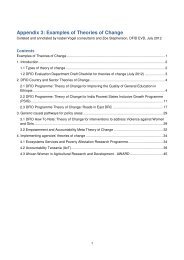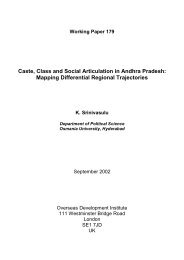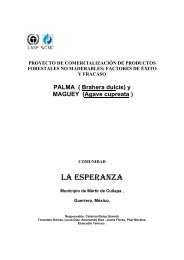Full Report - Research for Development - Department for ...
Full Report - Research for Development - Department for ...
Full Report - Research for Development - Department for ...
You also want an ePaper? Increase the reach of your titles
YUMPU automatically turns print PDFs into web optimized ePapers that Google loves.
Bergstrom<br />
(1991)<br />
(+)/(+)<br />
Women with<br />
preterm rupture of<br />
membranes<br />
Active management of third stage of labour<br />
Afolabi<br />
(2010)<br />
(+)/(-)<br />
Antimalarial<br />
Kietinun<br />
(1993)<br />
(-)/(-)<br />
Women in labour<br />
with term<br />
pregnancies and<br />
having vaginal<br />
delivery<br />
Pregnant women<br />
with malaria<br />
The intervention group received amoxicillin<br />
(100mg) and metronidazole (500mg), both<br />
drugs given three times daily. All patients<br />
were also routinely treated with an<br />
antimalarial dose of chloroquine. The<br />
control group was not given any<br />
pharmaceutical treatment, and labour was<br />
induced 3-24h after membrane rupture.<br />
Use of misoprostol in active management of<br />
third stage of labour to prevent primary<br />
postpartum haemorrhage. Group 1 received<br />
oral misoprostol. Group 2 received<br />
intramuscular oxytocin.<br />
Malaria cases were treated with a loading<br />
dose of quinine hydrochloride given<br />
intravenously at 20mg/Kg diluted in 250 ml<br />
5% dextrose in four hours, and then doses<br />
of 10 mg/Kg given at intervals of eight<br />
hours with the same dilution and rate until<br />
the patients were able to take the drug<br />
orally; 600 mg quinine sulphate was then<br />
given orally at eight-hourly intervals <strong>for</strong><br />
seven days.<br />
Maternal<br />
mortality<br />
Neonatal<br />
mortality<br />
Perinatal<br />
mortality<br />
Stillbirth<br />
Primary<br />
postpartum<br />
haemorrhage<br />
Maternal<br />
mortality<br />
Appendix 4.1<br />
While intrauterine mortality was<br />
approximately the same in both groups,<br />
neonatal mortality differed significantly<br />
(2.6 vs 19.2%). It is concluded that an<br />
expectant attitude, rather than an<br />
active and induction-oriented one, is<br />
most favourable in cases with preterm<br />
rupture of membranes, also in settings<br />
in which prevalence figures of sexually<br />
transmitted diseases and other genital<br />
infections are high.<br />
No occurrence of postpartum<br />
haemorrhage and no difference in<br />
secondary outcomes. Misoprostol judged<br />
as safe and effective as oxytocin.<br />
The overall maternal mortality rate in<br />
the obstetric department fell from 341<br />
per 100,000 live births to 54 per 100,000<br />
within five years, partly because of the<br />
improved care of pregnant women with<br />
malaria. Whereas in 1981 there were<br />
eight deaths among 379 pregnant<br />
women with the disease, in 1986 there<br />
were no deaths among 299 such cases.<br />
What are the effects of different models of delivery <strong>for</strong> improving maternal and infant health outcomes <strong>for</strong> poor people in urban areas in low income<br />
and lower middle income countries?<br />
203









